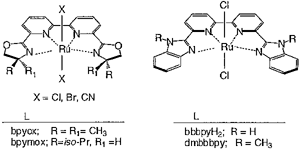
Kazuya MIZUSHIMA (Mie Univ.), Miho NAKAURA (Mie Univ.), Soon-Bong PARK (Toyohashi Inst. Tech.), Hisao NISHIYAMA (Toyohashi Inst. Tech.), Hideaki MONJUSHIRO, Kazumasa HARADA and Masa-aki HAGA
[Inorg. Chim. Acta 261, 175 (1997)]
New ruthenium complexes, trans-[RuX2(L)] (L = tetradentate 6,6'-bis(oxazolinyl or benzimidazolyl)-2,2'-bipyridine; X = halide or cyanide ion) have been synthesized. The present Ru complexes reveal a stable Ru(II/III) oxidation process and exhibit strong MLCT bands around 450 - 600 nm. The oxidation potential depends on the axial halogeno ligand; the potential increases in the order of X = Cl < Br < CN. The complexes possess the catalytic activity for oxidation of styrene and 1-phenylethanol. The bis(benzimidazolyl)-bipyridine complex has stronger oxidizing power compared to analogous bis(oxazolinyl)bipyridine complex.
